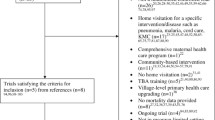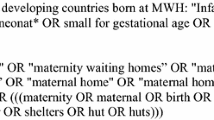Abstract
Background
The neonatal mortality rate (NMR) in India has remained virtually unchanged in the last 5 years. To achieve the Millennium Development Goal (MDG) 4 on child mortality (two thirds reduction from 1990 to 2015), it is essential to reduce NMR. A systematic review of the evidence on community-based intervention packages to reduce NMR is essential for advocacy and action to reach MDG-4.
Objective
To assess the effect of community based neonatal care by community health workers (CHWs) on NMR in resource-limited settings.
Design
Systematic review and meta-analysis of controlled trials.
Data sources
Electronic databases and hand search of reviews, and abstracts and proceedings of conferences.
Results
A total of 13 controlled trials involving about 192000 births were included in this systematic review. Community based neonatal care by CHWs was associated with reduced neonatal mortality in resource-limited settings [RR=0.73 (0.65 to 0.83); P<0.0001]. The identified studies were a heterogeneous mix with respect to the extent and quality of community based neonatal care provided and the characteristics of the CHWs delivering the intervention. There was no consistent effect of training duration of the health workers, type of intervention (home visitation versus community participatory action and learning), number of home visits done by CHWs, and provision of only preventive versus both preventive and therapeutic care. Limited data suggests that the ideal time for the first postnatal visit is the first two days of life. The interventions are highly effective when baseline NMR is above 50/1000 live births [RR=0.64(0.54 to 0.77)]. The interventions show a significant decrease in efficacy as the NMR drops below 50/1000 live births [RR=0.85 (0.73 to 0.99)], however is still substantial. NMR gains from home visitation approach are going to materialize only in the presence of high program coverage of 50% or more.
Conclusion
A significant decrease in NMR is possible by providing community based neonatal care in areas with high NMR by community health workers with a modest training duration and ensuring high program coverage with home visitation on the first two days of life.
Similar content being viewed by others
References
WHO Country Cooperation Strategy 2006–2011. http://www.searo.who.int/LinkFiles/WHO_Country_Cooperation_Strategy_-_India_Health_Development_Challenges.pdf. Accessed on May 1, 2011.
SRS Bulletin January 2011. http://www.censusindia.gov.in. Accessed on May 14, 2011.
The Million Death Study Collaborators. Causes of neonatal and child mortality in India: a nationally representative mortality survey. Lancet 2010:376;1853-60.
National_Fact_Sheet_CES_2009. UNICEF. http://www.unicef.org/india/National_Fact_Sheet_CES_2009.pdf. Accessed on May 1, 2011.
Darmstadt GL, Bhutta ZA, Cousens S, Adam T, Walker N, de Bernis L. Evidence-based, cost-effective interventions: how many newborn babies can we save? Lancet. 2005;365:977–988.
Gogia S, Sachdev HS. Home visits by community health workers to prevent neonatal deaths in developing countries: a systematic review. Bull World Health Organ. 2010;88:658–666.
Mathew JL, Shah D, Gera T, Gogia S, Mohan P, Panda R, et al. UNICEF-PHFI Series on Newborn and Child Health, India: Methodology for Systematic Reviews on Child Health Priorities for Advocacy and Action. Indian Pediatr. 2011;48:183–189.
Jokhio AH, Winter HR, Cheng KK. An intervention involving traditional birth attendants and perinatal and maternal mortality in Pakistan. N Engl J Med. 2005;352:2091–2099.
Baqui AH, El-Arifeen S, Darmstadt GL, Ahmed S, Williams EK, Seraji HR, et al. Effect of community-based newborn-care intervention package implemented through two service-delivery strategies in Sylhet district, Bangladesh: a cluster-randomised controlled trial. Lancet. 2008;371:1936–1944.
Bhutta ZA, Memon ZA, Sooi S, Salat MS, Cousens S, Martines J. Implementing community-based perinatal care: results from a pilot study in rural Pakistan. Bull World Health Organ. 2008;86:452–459.
Kumar V, Mohanty S, Kumar A, Misra RP, Santosham M, Awasthi S, et al. Effect of community-based behaviour change management on neonatal mortality in Shivgarh, Uttar Pradesh, India: a cluster-randomised controlled trial. Lancet. 2008;372:1151–1162.
Darmstadt GL, Choi Y, Arifeen SE, Bari S, Rahman SM, et al. Evaluation of a cluster-randomized controlled trial of a package of community-based maternal and newborn interventions in Mirzapur, Bangladesh. 2010 PLoS ONE 5(3):e9696. doi:10.1371/journal.pone.0009696.
Baqui AH, Williams EK, Rosecrans AM, Agrawal PK, Ahmed S, Darmstadt GL, et al. Impact of an integrated nutrition and health program on neonatal mortality in rural northern India. Bull WHO. 2008;86:796–804.
Bang AT, Bang RA, Baitule SB, Reddy MH, Deshmukh MD. Effect of home-based neonatal care and management of sepsis on neonatal mortality: field trial in rural India. Lancet. 1999;354:1955–1961.
Bang AT, Reddy HM, Deshmukh MD, Baitule SB, Bang RA. Neonatal and infant mortality in the ten years (1993 to 2003) of the Gadchiroli field trial: effect of home-based neonatal care. J Perinatol 2005;25(Suppl 1):S92–S107.
Bang AT, Bang RA, Baitule SB, Reddy HM, Deshmukh MD. Management of birth asphyxia in home deliveries in rural Gadchiroli: the effect of two types of birth attendants and of resuscitating with mouth-to-mouth, tube-mask or bag-mask. J Perinatol. 2005;25(Suppl 1):S82–S91.
Bang AT, Baitule SB, Reddy HM, Deshmukh MD, Bang RA. Low birth weight and preterm neonates: can they be managed at home by mother and a trained village health worker? J Perinatol. 2005;25(Suppl 1):S72–S81.
Bang AT, Bang RA, Stoll BJ, Baitule SB, Reddy HM, Deshmukh MD. Is home-based diagnosis and treatment of neonatal sepsis feasible and effective? Seven years of intervention in the Gadchiroli field trial (1996 to 2003). J Perinatol. 2005;25(Suppl 1):S62–S71.
Bang AT, Bang RA, Reddy HM, Deshmukh MD, Baitule SB. Reduced incidence of neonatal morbidities: effect of home-based neonatal care in rural Gadchiroli, India. J Perinatol. 2005;25(Suppl 1):S51–S61.
Bang AT, Bang RA. Background of the field trial of homebased neonatal care in Gadchiroli, India. J Perinatol. 2005;25(Suppl 1):S3–S10.
Bang AT, Bang RA, Reddy HM, Deshmukh MD. Methods and the baseline situation in the field trial of home-based neonatal care in Gadchiroli, India. J Perinatol. 2005;25(Suppl 1):S11–S17.
Bang AT, Bang RA, Reddy HM. Home-based neonatal care: summary and applications of the field trial in rural Gadchiroli, India (1993 to 2003). J Perinatol 2005;25(Suppl 1):S108–S122.
Azad K, Barnett S, Banerjee B, Shaha S, Khan K, Rego AR, et al. Effect of scaling up women’s groups on birth outcomes in three rural districts in Bangladesh: a clusterrandomised controlled trial. Published Online March 8, 2010; doi:10.1 1016/S0140-6736(10)60142-0.
Tripathy P, Nair N, Barnett S, Mahapatra R, Borghi J, Rath S, et al. Effect of a participatory intervention with women’s groups on birth outcomes and maternal depression in Jharkhand and Orissa, India: a cluster-randomised controlled trial. Published online March 8, 2010; doi: 10.1016/S0140-6736(09)62042-0.
Manandhar DS, Osrin D, Shrestha BP, Mesko N, Morrison J, Tumbahangphe KM, et al. Effect of a participatory intervention with women’s groups on birth outcomes in Nepal: cluster-randomised controlled trial. Lancet. 2004;364:970–979.
Bhutta ZA, Soofi S, Cousens S, Mohammad S, Memon ZA, Ali I, et al. Improvement of perinatal and newborn care in rural Pakistan through community-based strategies: a cluster-randomised effectiveness trial. Lancet. 2011;377:403–412
Greenwood A, Bradley A, Byass P. Evaluation of a primary health care program in The Gambia. I. The impact of trained traditional birth attendants on the outcome of pregnancy. J Trop Med Hyg. 1990;93:58–66.
Kafatos AG, Teltoura S, Pantelakis SN, Doxiadis SA. Maternal and infant health education in a rural Greek community. Hygiene. 1991;10:32–37.
Carlo WA, Goudar SS, Jehan I, Chomba E, Tshefu A, Garces A, et al, and the First Breath Study Group. Newborn-Care Training and Perinatal Mortality in Developing Countries. N Engl J Med. 2010;362:614–623.
Author information
Authors and Affiliations
Corresponding author
Electronic supplementary material
Rights and permissions
About this article
Cite this article
Gogia, S., Ramji, S., Gupta, P. et al. Community based newborn care: A systematic review and meta-analysis of evidence: UNICEF-PHFI series on newborn and child health, India. Indian Pediatr 48, 537–546 (2011). https://doi.org/10.1007/s13312-011-0096-8
Published:
Issue Date:
DOI: https://doi.org/10.1007/s13312-011-0096-8




